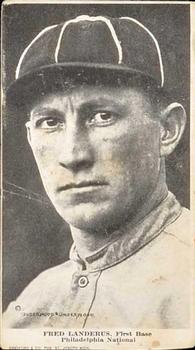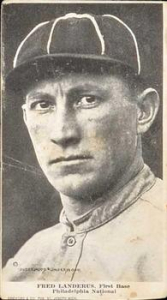Fred Luderus
Though acknowledging that Fred Luderus “is not a Stuffy McInnis on defense, nor a Jake Daubert in batting, nor a Fred Merkle on the baselines,” J. C. Kofoed in the July 1915 issue of Baseball Magazine called the Phillies first baseman “the most under-rated man in baseball today.” A pure fastball hitter who feasted on pitches between his waist and shoulders, Luderus reached double digits in home runs each season from 1911 to 1914. Only a fair fielder (he led National League first basemen in errors four times) and never a streak of lightning on his feet (his nine stolen bases in 1915 were a career high), the modest Ludy became known for his dependability after his home-run hitting dropped off. From 1916 to 1919 he played in 533 consecutive games, considered “the greatest streak of continuous play by a modern major leaguer.”
Frederick William Luderus (pronounced loo-DARE-us) was born in Milwaukee on September 12, 1885. In his teenage years the thick-boned, heavy-muscled German-American earned a reputation on the Milwaukee sandlots as a rugged first baseman, eventually signing to play professionally in 1905 with Sault Ste. Marie of a short-lived Class D circuit called the Copper Country Soo League. The following season it became known as the Northern Copper Country League, and Luderus returned each year (with Grand Forks until that team disbanded, and then with Winnipeg) until the struggling circuit folded after the 1907 season.
After sitting out most of the 1908 season with diphtheria, Fred resumed his career in 1909 with Freeport, Illinois, and led the Wisconsin-Illinois League in hitting with a .321 average. On the recommendation of scout George Huff, the Chicago Cubs purchased his contract late that season for $2,200. The 24-year-old Luderus replaced the disappointing Del Howard as principal backup for the oft-injured Frank Chance. Setting foot in a big-league ballpark for the first time on September 23, 1909, Fred batted .297 and drove in nine runs in 11 games with the Cubs. At West Side Grounds on September 29 he connected for an inside-the-park home run, the first of his lifetime 84 homers in the majors. Ironically, it was the only one he hit for a team other than the Phillies, and it came against the Phillies’ Lew Moren.
In 1910 Chance used second-string catcher Jimmy Archer as his primary backup at first base. Luderus played infrequently, batting .204 in just 54 at-bats, and in late July the Cubs traded him to Philadelphia for journeyman lefthander Bill Foxen. The Phillies intended to use Luderus as a temporary replacement for the ailing Kitty Bransfield, but Ludy batted .294 down the stretch with 14 RBIs in 21 games, forcing manager Red Dooin to consider him as a candidate for the first-base job in 1911. At training camp in Birmingham, Alabama, the following spring, the 36-year-old Bransfield failed to regain his former prowess and Luderus stole his position.
Most believed that Bransfield would win his position back once the warmer weather arrived, but the Phillies ended up releasing the popular veteran when the left-handed hitting (but right-handed throwing) Luderus started popping balls over Baker Bowl‘s short right-field fence. It was nearly four weeks into the campaign before the rookie hit his first homer, but he then collected five in 13 days. After another month’s drought, the streaky Luderus smashed nine during a four-week period. On July 15, 1911, he became the first player in Phillies history to hit two over-the-fence home runs in a single game, in the process establishing himself as the National League’s leader in home runs with 14. Ludy notched just two more over the final 12 weeks, but he hit .301 for the season and his 16 circuit clouts led the Phillies and ranked second in the NL behind Wildfire Schulte‘s 21. He finished third in the NL in RBIs (99) and total bases (260).
In 1913 Luderus clubbed a career-high 18 home runs—three more than the entire St. Louis Cardinals team, but one less than teammate Gavy Cravath. Out-of-town sportswriters constantly poked fun at the bumper crop of home runs in Philadelphia, blaming it on the “cigar box” the Phillies played in. To a certain extent their criticism was valid. The Phillies did hit 51 of their major-league-leading 73 home runs at Baker Bowl, but they also led the majors in home runs hit on the road. Luderus took as much advantage of Baker Bowl’s short right field as nearly anyone; 75% of his 83 home runs in a Phillies uniform came at home.
Ludy’s most enjoyable season undoubtedly was 1915, when new manager Pat Moran appointed him captain and the Quakers captured their first National League pennant. Though he hit only seven home runs, down from 12 the previous season, Luderus set career-highs in batting average (.315) and doubles (36), finishing second in the NL behind the Giants’ Larry Doyle in both categories. In that year’s World Series, Fred was a shining star in defeat, batting .438 (the Phillies collectively batted .182) with the Phillies’ lone home run and six of his club’s nine RBIs.
Luderus’ ability to hit home runs didn’t return after 1915; he hit exactly five home runs in each of the next four seasons despite not missing a single game after June 2, 1916. In fact, he received as much attention for his durability as he ever had for his slugging. On August 3, 1919, Luderus played his 479th consecutive game, breaking the modern record of 478 set only one year earlier by Eddie Collins of the White Sox. Ludy’s streak had almost ended earlier in 1919. Phillies manager Jack Coombs had started another first baseman because Fred was suffering from a charley horse, but baseball record-keeper Al Munro Elias was at the ballpark that day and pleaded with Coombs to get Luderus into the game. Coombs sent Fred in to pinch hit and the streak survived. On September 24, 1919, the 527th and 528th games of the streak, the Phillies honored their dependable first baseman with a “Fred Luderus Day,” presenting him with a gold watch and diamond stickpin between games of a doubleheader.
The streak continued until Opening Day of the 1920 season. Suffering from an attack of lumbago, Luderus was unable to play and the streak ended at 533 games, which remained the 20th century National League record until the otherwise unremarkable Glass Arm Eddie Brown broke it in 1927. Fred’s back condition proved serious; he appeared in just 16 games in 1920, his last season in the major leagues. Beginning in 1921, he spent 10 of the next 13 years managing in the minor leagues, eight as a player-manager. Ludy could still hit. In 1923 he batted .362 and led Oklahoma City to the Western League pennant. With the same club the following season Luderus claimed to have taught a young Carl Hubbell how to throw a screwball. All told, he spent seven seasons managing in the Oklahoma capital.
After retiring from baseball, Luderus returned to Milwaukee and worked as the grounds supervisor at the Milwaukee Yacht Club. With professional assistance from former teammate Cy Williams, who had become an accomplished architect, he built a house in the Three Lakes region of northern Wisconsin. Eventually Luderus started his own toy business, developing a national market for dolls and animals made of yarn. On the occasion of his induction into the Wisconsin Athletic Hall of Fame on November 20, 1958, Milwaukee Braves general manager John Quinn called him “an inspiration to the youth of Milwaukee and Wisconsin.”
Fred Luderus suffered a fatal heart attack at his home in Three Lakes on the evening of January 5, 1961. Survived by his wife, Emmy, and three daughters, he was buried in Milwaukee’s Pinelawn Cemetery.
Note: A slightly different version of this biography appeared in Tom Simon, ed., Deadball Stars of the National League (Washington, D.C.: Brassey’s, Inc., 2004).
Sources
For this biography, the author used a number of contemporary sources, especially those found in the subject’s file at the National Baseball Hall of Fame Library.
Full Name
Frederick William Luderus
Born
September 12, 1885 at Milwaukee, WI (USA)
Died
January 5, 1961 at Three Lakes, WI (USA)
If you can help us improve this player’s biography, contact us.



